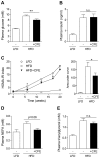Antidiabetic effects of chamomile flowers extract in obese mice through transcriptional stimulation of nutrient sensors of the peroxisome proliferator-activated receptor (PPAR) family
- PMID: 24265809
- PMCID: PMC3827197
- DOI: 10.1371/journal.pone.0080335
Antidiabetic effects of chamomile flowers extract in obese mice through transcriptional stimulation of nutrient sensors of the peroxisome proliferator-activated receptor (PPAR) family
Abstract
Given the significant increases in the incidence of metabolic diseases, efficient strategies for preventing and treating of these common disorders are urgently needed. This includes the development of phytopharmaceutical products or functional foods to prevent or cure metabolic diseases. Plant extracts from edible biomaterial provide a potential resource of structurally diverse molecules that can synergistically interfere with complex disorders. In this study we describe the safe application of ethanolic chamomile (Matricaria recutita) flowers extract (CFE) for the treatment and prevention of type 2 diabetes and associated disorders. We show in vitro that this extract activates in particular nuclear receptor peroxisome proliferator-activated receptor gamma (PPARγ) and its isotypes. In a cellular context, in human primary adipocytes CFE administration (300 µg/ml) led to specific expression of target genes of PPARγ, whereas in human hepatocytes CFE-induced we detected expression changes of genes that were regulated by PPARα. In vivo treatment of insulin-resistant high-fat diet (HFD)-fed C57BL/6 mice with CFE (200 mg/kg/d) for 6 weeks considerably reduced insulin resistance, glucose intolerance, plasma triacylglycerol, non-esterified fatty acids (NEFA) and LDL/VLDL cholesterol. Co-feeding of lean C57BL/6 mice a HFD with 200 mg/kg/d CFE for 20 weeks showed effective prevention of fatty liver formation and hepatic inflammation, indicating additionally hepatoprotective effects of the extract. Moreover, CFE treatment did not reveal side effects, which have otherwise been associated with strong synthetic PPAR-targeting molecules, such as weight gain, liver disorders, hemodilution or bone cell turnover. Taken together, modulation of PPARs and other factors by chamomile flowers extract has the potential to prevent or treat type 2 diabetes and related disorders.
Conflict of interest statement
Figures








Similar articles
-
Lemon balm extract causes potent antihyperglycemic and antihyperlipidemic effects in insulin-resistant obese mice.Mol Nutr Food Res. 2014 Apr;58(4):903-7. doi: 10.1002/mnfr.201300477. Epub 2013 Nov 24. Mol Nutr Food Res. 2014. PMID: 24272914
-
P633H, a novel dual agonist at peroxisome proliferator-activated receptors alpha and gamma, with different anti-diabetic effects in db/db and KK-Ay mice.Br J Pharmacol. 2009 Jul;157(5):724-35. doi: 10.1111/j.1476-5381.2009.00231.x. Epub 2009 May 5. Br J Pharmacol. 2009. PMID: 19422369 Free PMC article.
-
A novel fatty acid mimetic with pan-PPAR partial agonist activity inhibits diet-induced obesity and metabolic dysfunction-associated steatotic liver disease.Mol Metab. 2024 Jul;85:101958. doi: 10.1016/j.molmet.2024.101958. Epub 2024 May 17. Mol Metab. 2024. PMID: 38763495 Free PMC article.
-
New peroxisome proliferator-activated receptor agonists: potential treatments for atherogenic dyslipidemia and non-alcoholic fatty liver disease.Expert Opin Pharmacother. 2014 Mar;15(4):493-503. doi: 10.1517/14656566.2014.876992. Epub 2014 Jan 16. Expert Opin Pharmacother. 2014. PMID: 24428677 Review.
-
Peroxisome Proliferator-Activated Receptors (PPAR), fatty acids and microRNAs: Implications in women delivering low birth weight babies.Syst Biol Reprod Med. 2021 Feb;67(1):24-41. doi: 10.1080/19396368.2020.1858994. Syst Biol Reprod Med. 2021. PMID: 33719831 Review.
Cited by
-
Integrating experimental model, LC-MS/MS chemical analysis, and systems biology approach to investigate the possible antidiabetic effect and mechanisms of Matricaria aurea (Golden Chamomile) in type 2 diabetes mellitus.Front Pharmacol. 2022 Sep 7;13:924478. doi: 10.3389/fphar.2022.924478. eCollection 2022. Front Pharmacol. 2022. PMID: 36160451 Free PMC article.
-
Potential Therapeutic Benefits of Herbs and Supplements in Patients with NAFLD.Diseases. 2018 Sep 10;6(3):80. doi: 10.3390/diseases6030080. Diseases. 2018. PMID: 30201879 Free PMC article. Review.
-
Iberis amara Extract Induces Intracellular Formation of Reactive Oxygen Species and Inhibits Colon Cancer.PLoS One. 2016 Apr 6;11(4):e0152398. doi: 10.1371/journal.pone.0152398. eCollection 2016. PLoS One. 2016. PMID: 27050665 Free PMC article.
-
Ameliorative effects of half-dose saffron and chamomile combination on Psycho-endocrinological changes in a diabetic murine model.PLoS One. 2022 Oct 27;17(10):e0276236. doi: 10.1371/journal.pone.0276236. eCollection 2022. PLoS One. 2022. PMID: 36302045 Free PMC article.
-
New approaches to the treatment of metabolic dysfunction-associated steatotic liver with natural products.ILIVER. 2024 Nov 8;3(4):100131. doi: 10.1016/j.iliver.2024.100131. eCollection 2024 Dec. ILIVER. 2024. PMID: 40635852 Free PMC article. Review.
References
-
- WHO (2003) Obesity and Overweight - Fact sheet.
Publication types
MeSH terms
Substances
LinkOut - more resources
Full Text Sources
Other Literature Sources
Medical

